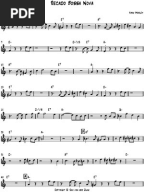Lennie Tristano Transcriptions Pdf Editor
Lennie Tristano by Released February 1956 Recorded 1954–55; June 11, 1955, chronology Descent into the Maelstrom (1952) Descent into the Maelstrom1952 Lennie Tristano (1955) New York Improvisations (1956) New York Improvisations1956 Professional ratings Review scores Source Rating Lennie Tristano, also known as Tristano, is a 1956 album by pianist. At its release, the album was controversial for its innovative use of technology, with Tristano piano and manipulating tape speed for effect on the first four tracks. The final five songs are concert recordings. Originally released as Tristano's debut, the album was released on CD in 1994 by in combined form with Tristano's 1960 follow-up, and as part of a collection, The Complete Atlantic Recordings of Lennie Tristano, Lee Konitz & Warne Marsh, in 1997. It was subsequently re-issued in original form and track-list order by (2002), Rhino (2003) and (2004).
In 1997, dubbed the album a masterpiece. Describes the album as 'gorgeous.
With a beautiful juxtaposition between the first half and the second half between the rhythmic and intervallic genius of Tristano as an improviser and as a supreme lyrical and swinging harmonist on the back half'. Contents. Controversial innovation According to in The Masters of Be-Bop, the overdubbing and tape speed manipulation on this album unleashed a furor.
Lennie Tristano Transcriptions Pdf To Jpg. 5/12/2017 0 Comments. Editor receives articles of empirical research and reviews in management agribusiness.
Tristano had begun experimenting in 1951, when he had additional piano tracks, some of which had been speeded up by Rudy van Gelder, added to his recording of the songs 'Ju Ju' and 'Pastime'. Tristano later recalled that not a single reviewer questioned the multitracking of those songs. According to Tristano, questions began to arise six months to a year later. At the time, Tristano declined to discuss it. In an interview years later, he described a private incident where and Willie Kapell debated the topic in his home. After Bernstein declared his certainty that the songs were multitracked, Kapell demonstrated that the speed was possible by playing a tune 16 times faster than it would generally be played.
Following the release of Lennie Tristano, the usage of multitracking and tape speed was widely questioned and criticized on the songs 'Line Up', 'Turkish Mambo' and 'East Thirty-Second'. In the case of 'Turkish Mambo', Tristano played three separate and conflicting piano tracks, with left-hand rhythms of five, six and seven beats beneath right-hand improvisation. Tristano made specific reference to that song in defending his choice, stating that 'if I do multiple tapes, I don't feel I'm a phony thereby. Take 'The Turkish Mambo'.
There is no other way I could do it so that I could get the rhythms to go together the way I feel them.' On the question of tape speed, he added, 'If people want to think I speeded up the piano on 'Line Up' and 'East Thirty-Second', I don't care. What I care about is that the result sounded good to me.' Contributing, inspired to later use the same technique on his own album Looking Out, argued on the contrary to those who feel this is a deceptive technique that it is simply another tool an artist may use to craft his work. Though controversial immediately on release, Tristano's decision to use the technique was described in 1997 by The New York Times as 'celebrated'. Track listing All tracks composed by, except where noted.

'Line Up' – 3:34. 'Requiem' – 4:53. 'Turkish Mambo' – 3:41. 'East Thirty-Second' – 4:33.
Vw t5 transporter bedienungsanleitung pdf writer. ' (, ) – 5:46. ' (, ) – 5:20.
' (Jimmy Campbell, Reginald Connelly, ) – 6:29. ' (, ) – 6:07. ' (, ) – 6:11 Personnel Lennie Tristano's home studio, New York, 1954-1955. Tracks 1-4. –. – (tracks: 1, 4). Jeff Morton – (tracks: 1, 4) The Sing-Song Room, Confucius Restaurant, New York, June 11, 1955.
Tracks 5-9. Lennie Tristano – piano. –. – bass.
– drums Design. –. Jay Maisel – artwork References. Lennie Tristano / The New Lennie Tristano (Liner Notes). Lennie Tristano. 8122-71595-2 (Atlantic 1224). ^ at.
^ Ratliff, Ben (1997-12-14). The New York Times. Retrieved 2008-05-12.
^ Gitler, Ira (18 February 2009). Google Books. Da Capo Press. Retrieved 29 September 2016. ^ Gitler, 238. Martin, Henry; Waters, Keith (1 January 2006).
Kenny Werner Transcriptions Pdf
Google Books. Retrieved 29 September 2016. Songs and composers from. Track length information from at.
John Mclaughlin Transcriptions Pdf
^ Togashi, Nobuaki; Matsubayashi, Kohji; Hatta, Masayuki. Retrieved 2012-06-14.